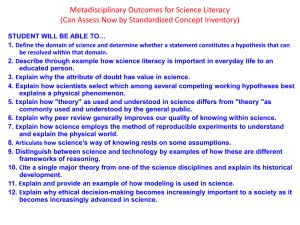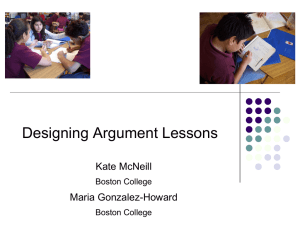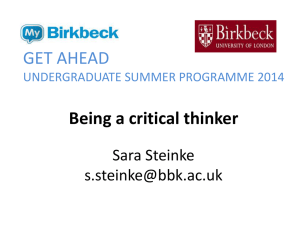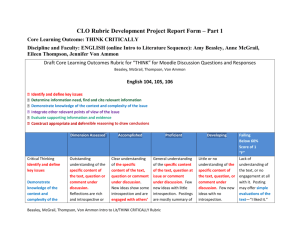Parallel Reasoning (Thomson)
advertisement
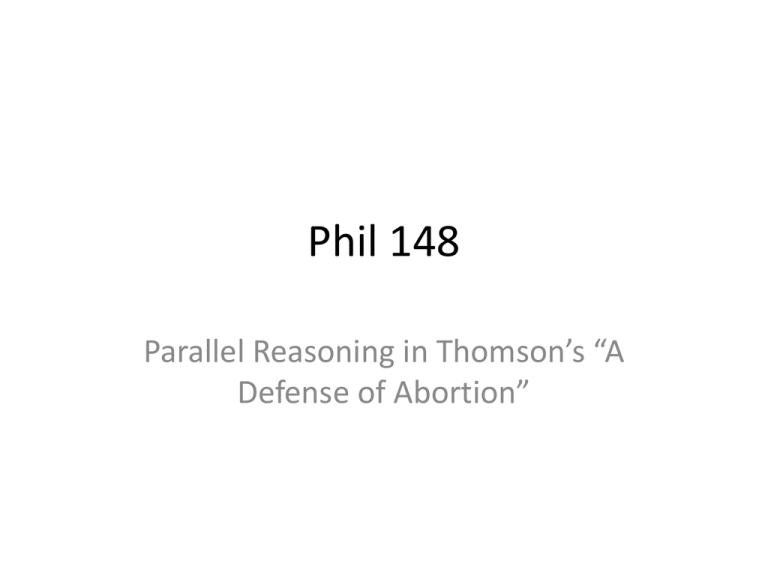
Phil 148 Parallel Reasoning in Thomson’s “A Defense of Abortion” Parallel Reasoning • Sometimes, when an argument is invalid or otherwise problematic, it is easier to refute by constructing a parallel argument that is more clearly problematic. • A parallel argument is one that retains the same structure and other relevant features but that is more clearly problematic than the original. Examples: • From the text: – “If I had a higher salary, I could buy more things; so if everyone had higher salaries, everyone could buy more things.” vs. “If one person stands up at a ballgame, he will get a better view; so if everyone stands up at a ballgame, everyone gets a better view” – “If guns are outlawed, only outlaws will have guns” vs. “If gum is outlawed, only outlaws will have gum.” • Other: – “The Heat have the best players, so they have the best team” vs. “That is the most beautiful building on the block, so it must have the most beautiful nails and rivets on the block” Evaluating Parallel Reasoning 1. Is the parallel argument actually problematic? (i.e. are the parallel premises true while the parallel conclusion is false?) If not, then the refutation by parallel reasoning is unsuccessful. 2. Does the parallel argument really have the same form as the original? If not, then the refutation by parallel reasoning is unsuccessful. Parallel Reasoning in Ethics • Parallel reasoning in ethics can be a very useful tool. When we encounter something that we are unsure about ethically, what we can do is see if it is relevantly similar to something that we are sure about ethically. – E.g. is downloading copyrighted electronic music more like dipping a glass of water from a river that you do not own or like taking someone else’s property from their home? • Parallel reasoning is one way to justify some claims in ethics, so long as it is done well. Thomson’s approach: • Thomson’s approach is primarily defensive. She does not mean to categorically support any and all cases of abortion. Instead she wishes to more closely examine common assertions concerning positions that categorically deny any and all cases of abortion. Notable features of both positions: • “Personhood” will end up having nothing at all to do with either essay’s conclusions (in fact, Thomson assumes for the sake of argument that a fetus is a person, while Marquis assumes for the sake of argument that a fetus is not a person) • Religious reasoning makes no appearance whatsoever. The nature of rights Rights are claims to some moral good, and as such there are two kinds of rights: - Positive: rights that put a definite claim onto another person or entity (e.g. a right to education) - Negative: rights that put a claim on all to refrain from something (e.g. property rights) It is not enough to simply claim that a person has a right to something. One must defend the claim that the right entails in order for the right to be justified. Thompson on Rights • Thompson explicitly addresses both forms of the right to life, and addresses each in a variety of ways. • Each of the parallel arguments assumes one version of the right to life or another. Evaluating parallel reasoning in Thompson • First, note that there are MANY parallel arguments in Thompson, each with its own distinct purpose. • Among these are: – Violinist case (which has several scenarios, depending on what is being addressed) – Henry Fonda – 2 boys with one coat – 2 boys jointly given one box of chocolates – Growing person in the house – Burglar in the house – People-seeds in the house Violinist/Fonda Cases • These cases all attempt to zero in on what people owe to others in need, and to what extent people are morally required to accept sacrifices for the sake of those others. 2 Boys cases: • These cases all concern ownership, and what we do or do not owe others in need when circumstances involve what is owned by one party or another House cases: • These cases concern ownership and what obligations that others owe to those who own things, even when they need those things. Evaluating parallel reasoning in Thompson • Now, consider the specific cases. • 1. Determine what claim Thompson is meaning to establish/refute. • 2. Determine whether the morally relevant aspects of the parallel case match. • 3. Determine whether the conclusion of the parallel case is as Thompson indicates.


